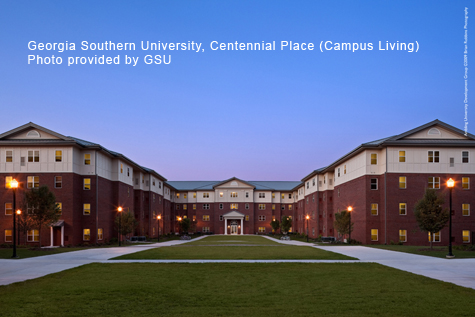|
||||||
|
Erika Johnson, a planner in our office who is also responsible for coordinating our marketing has been researching the results of public/private partnerships on college and university campuses. In this issue, she writes about student housing delivered in this way. Erika is continuing her research and preparing an in depth article for future publication. George discusses some important characteristics of good planning teams for institutions to consider when preparing to engage consultants and development partners. If you have reactions or ideas to share, please let us know what you think by e-mailing: editor@dlmplanners.com |
||||||
|
Universities are finding that this is a beneficial arrangement for a number of reasons. For one, it provides the obvious advantage of deferring the delivery and budget risks to the developer as well lessening the impact of the debt to the university’s books. This also makes the developer solely accountable for completing the project on time. When students sign contracts for the housing months in advance, they and their parents fully expect to move in at the designated date before the semester begins. If a project gets behind schedule and the facility is not ready for occupancy on day one of the contract, the developer is charged with finding suitable accommodations, usually in a nearby hotel, and arranging transportation to campus.
This partnership structure also leads to a more manageable bidding process that greatly reduces the amount of time and money needed to go from project inception to completion. As opposed to a standard process, whereby the university bids out separately for planning, design, and construction services in stages, with public-private development the university issues a single RFP for full-service developer-led teams. The developer is able to assemble a specialized team of architects, engineers, and contractors and leads the process while working intimately with university administration. The value of this type of integrated planning is that it allows for the entire team to discuss design and specification issues as they happen, rather than requiring the construction team to loop back with the design team over discrepancies, helping to keep the project on budget and on schedule. The development and construction process is also more streamlined because the developer is required to guarantee the design to the exact specifications agreed on by the University at a guaranteed maximum price. Georgia , like a number of other states, does not provide public funding for housing development, which leads most public colleges and universities in the state to pursue public-private partnerships to increase their housing stock. In particular, Georgia Southern University in Statesboro, Ga. has built 2,900 new beds since 2003, each with varying design programs and rental rates, to attract undergraduate students to on-campus living throughout their college years. The most recent project to open is Centennial Place, completed in partnership with Ambling University Development Group, which includes 1,001 beds in apartments and suites as well as 10,000 SF of retail space. For this development, GSU’s third public-private housing development, the University set up a separate single-purpose non-profit LLC to own the project. GSU manages and maintains the property as part of its current housing program, with the LLC board providing oversight of the building’s finances and repair costs.
In the end, it’s the institution’s students, faculty, or staff, not the development team, who will be the users. As Vickie Hawkins, Director of Housing for Georgia Southern University, states, what is most important in the relationship is to choose a developer that is willing to treat the university as a customer and work collaboratively. “When disagreements arose on issues such as how much money was allocated to the project, interpretation of the contract, or interpretation of the University’s architectural standards, the clear, open, and honest communication as well as the strong working relationship that the university and developer had established was the key to effectively resolving these issues. You cannot have an adversarial relationship and get what you want out of the project.” The university’s administration has to be very involved with decisions on the design and material selection throughout the project.
Hawkins, who has been with Georgia Southern University for 30 years, offers the following advice for institutions seeking to enter into a public-private partnership.
Public-private partnerships do not work for all campus housing projects, but they do allow universities to drastically increase the stock of on-campus housing and other revenue producing campus facilities without relying on public money or donations. While it is too early to understand the long-term implications of this type of development, to date it has allowed a more efficient and collaborative process that can create a winning formula for both the universities and development teams involved.
|
|||||||
Erika’s piece on public-private housing partnerships stresses the critical importance of the project team to ensure the good communication that leads to a high-quality outcome. Over the years, many institutions have increasingly preferred planning project teams composed of multiple firms to ensure maximum coverage of all systems from academic to waste water. These large teams require strong leadership. The team’s lead firm must have deep experience in-house and good team management and coordination skills.
Applying all team members’ talents to the project in appropriate amounts at the right time requires clarity about desired outcomes as a key starting point. While the project team can help identify, refine and articulate the scope and depth of deliverables, this is fundamentally a client responsibility, so spend some time during the drafting of the RFP focusing on the specifics of the deliverables. After all, these are the tangible products that will represent the many hours of work and collaboratively-generated wisdom of the project team. The documents will be used over several years to guide decisions on campus development. Talk with your colleagues about what your institution requires of these products? Who will use them? How will you use them? Answers to these questions early in the project will guarantee a satisfactory outcome. When evaluating teams, consider combining local expertise with national (or even international) experience. Teams that meld these perspectives and knowledge will provide stronger input and richer solutions. If yours is a large, complex institution, a large, complex team may well be necessary. For smaller colleges and universities, a small team is beautiful. If specialized assessments and knowledge are required, these skills can be added to the team as needed in a focused way, rather than bloating the team (and its fees) from project inception to completion. Finally, in team selection, pay attention to the personality and character of the team leader. Campus plans typically take several months to complete, and the quality of the relationship with this person can make the difference between an adequate and an excellent plan.
|
||||
|
||||||||
© Copyright 2010
|
||||||||






